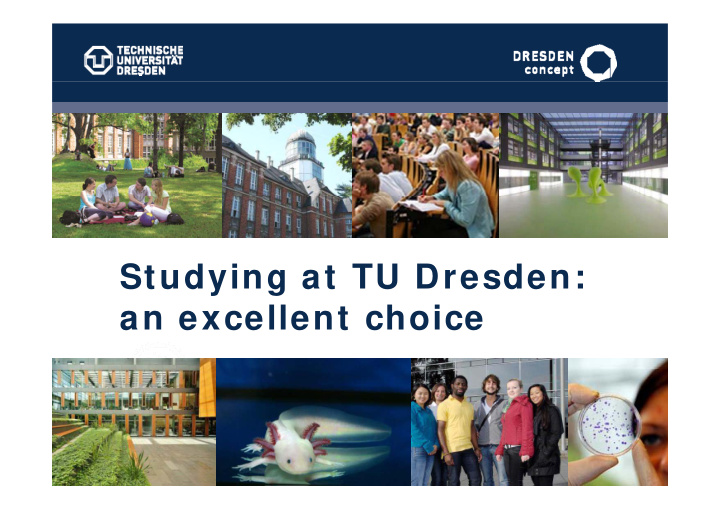



Studying at TU Dresden: an excellent choice an excellent choice
W here is Dresden? Dresden, Germany Dresden, Germany
W hat do I need to know about TUD? One of 11 universities of excellence in Germany Founded in 1828 Students: 36.737 (2014/ 2015) Freshmen: 9.055 (2014/ 2015) International Students: 4640 (~ 13% ) i l S d 6 0 ( 3% ) Programmes: ~ 120 (Bachelor, Diplom, Staatsexamen, Master) Various exchange programmes Various exchange programmes
The Main Campus The Main Campus Lecture Hall Medical Campus Medical Campus Theatre
The Medical Campus Diagnostic-Internal-Neurological Centre l l l C Bio-Innovation Centre emergency room, surgery centre Max Planck Institute nucleus of the former for Molecular Cell municipal hospital Biology and Genetics gy University < –> University Hospital = 3 mi / 6.5 km paediatric and obstetri clinic li i Medical-Theoretical Centre Slide 5
Tharandt: University & Arboretum/ Botanical Garden bridge: award-winning original forest dating before original forest dating before teaching facilities, student project d 1831; greenhouses, tree library, cafeteria nursery, museum North American forest formations
Monument listed buildings on campus 1 3 2 2 4 5 6 1 Fritz-Foerster Bau 2 Schuhm ann Bau 3 W eberplatz 4 Beyer Bau 5 Görges Bau ( Altana Gallery) 6 Tharandt
Functional New Buildings 1 1 3 2 4 4 5 4 6 5 1 Hörsaalzentrum ( 1 9 9 8 ) 2 Chem istry ( 2 0 0 1 ) 3 Paediatrics Clinic (2003) 4 Biology ( 2 0 0 4 ) 5 Com puter Science ( 2 0 0 6 ) 6 CRTD ( 2 0 1 1 )
Excellent Research Conditions 3 2 1 4 5 6 1 SLUB ( Library) 2 Zebrafish facility ( CRTD) 3 CRTD 4 Wafer in cleanroom ( NaMLab) 5 MRT 6 High voltage lab
5 Schools | 14 Faculties Civil and i il d Engineering Sciences Hum anities and Environm ental Science Medicine Social Sciences Engineering Mathematics Medicine (incl. Computer Science Business and Architecture U i University it Electrical and Civil Engineering Economics Physics Hospital) Education Environmental Computer Chemistry Law Engineering Sciences Linguistics, Mechanical Transport and Psychology Psychology Science and Literature and Traffic Sciences Biology Engineering Cultural Studies Arts, Humanities and Social Science
Five Research Priority Areas h 1. Health Sciences| Biomedicine | Bioengineering 2. Information Technologies | Microelectronics 3. Smart Materials and Structures 4. Culture and Knowledge 5. Energy and Environment gy
How can I study at TUD? A) For a degree B) Non-degree ( exchange student) • Knowledge of German (B1) or English (if programme taught in English) • Learning agreement • Proof of enrolment at home/ approved by home uni C) Doctoral Studies
How m uch does it cost? How m uch does it cost? • living in student hall (120 – 300 Euro/ month) or shared accommodation is possible accommodation is possible • total living costs about 650 Euro/ month (~ 23.800NT$) (incl rent food books (incl. rent, food, books, transport)
How m uch does it cost? • no tuition fees but a student service “ “payment” – at present t” t t 257,90 Euro per semester (incl. semester ticket) ~ 9.500NT$ The sem ester ticket: The sem ester ticket: • public transport, Dresden and its surrounding, all regional trains in Saxony
W hat else is there to do? • Very vibrant „young“ quarters with lots of discos/ clubs/ bars • Many museums, theatres, h cinemas • 91 libraries and archives 91 libraries and archives • Many festivals(music, art, dance, cinema,… ) • B Beautiful surroundings for hiking, if l di f hiki climbing, etc.
Can I do sports at TUD? • „ Universitätssportzentrum“ (USZ), offers more than 100 courses (Yoga, Volleyball, Climbing, Canooing, Swimming,… g, ) each semester for a ) small fee • more than 300 clubs in Dresden th 300 l b i D d • 2 big stadiums to watch others • 2 big stadiums to watch others doing sports ; ) (football, American Football, Volleyball,… )
Thank you very m uch for your attention! Julia Paternoster International Office Technische Universität Dresden Julia.Paternoster@tu-dresden.de Julia.Paternoster@tu dresden.de + 49-351-463-37806 http: / / tu-dresden.de/ international
Excellence I nitiative: targets and m easures to make Germany a more attractive research location to make German universities more competitive on an international to make German universities more competitive on an international level to focus the attention on the outstanding achievements of German universities and the German scientific community universities and the German scientific community 1 st funding line: 2 nd funding line: 3 rd funding line: CLUSTERS OF I NSTI TUTI ONAL GRADUATE SCHOOLS SCHOOLS EXCELLENCE EXCELLENCE STRATEGY STRATEGY promoting young promoting young top-notch research top notch research institutional institutional researchers development
Excellence I nitiative | 2 nd phase: projects funded projects funded 2 0 1 2 - 2 0 1 7 ( 2 ,4 billion Euros) : 45 Graduate Schools 43 Clusters of Excellence 43 Clusters of Excellence 11 Institutional Strategies (Universities of Excellence) ll ) 3 9 universities funded
Funded proposals of TU Dresden 1 st funding line: 2 nd funding line: 3 rd funding line: GRADUATE CLUSTERS OF I NSTI TUTI ONAL SCHOOL EXCELLENCE STRATEGY Dresden International Center for The Synergetic Graduate School for Regenerative University Biomedicine and Therapies Dresden Bioengineering oe g ee g (CRTD) (CRTD) (DIGS-BB) Center for Advancing Electronics (cfAED)
Recommend
More recommend